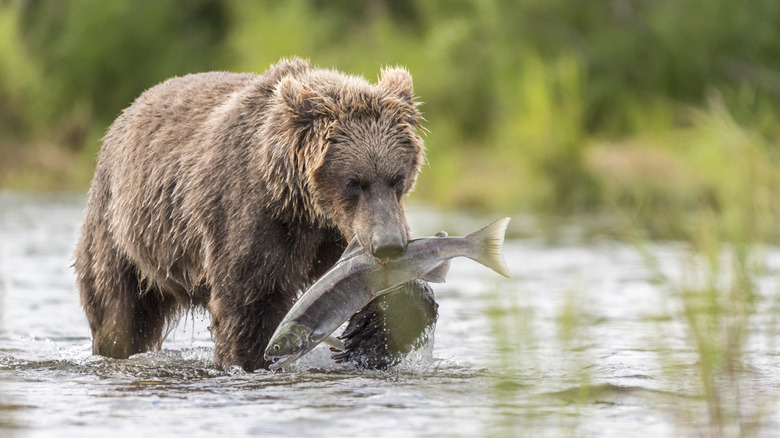Alaska's Underrated National Park Is A Top Brown Bear Viewing Destination With Views Unlike Anywhere In The World
Alaska, which occupies the northwestern corner of North America, is among the most geographically diverse states in the U.S. It contains over a dozen major mountain ranges, more than 100 volcanoes and volcanic fields, and a vast array of glaciers. This unique combination of natural wonders combined with a relatively small human population has nurtured a rich variety of wildlife. But none are perhaps as cherished and revered as the pantheon of bear species. Polar bears, black bears, and brown bears all roam through the wilds of Alaska. In fact, the state is home to approximately 100,000 black bears, more than any other U.S. state. More elusive than their black counterparts are the formidable brown bears, who are seldom spotted en masse. That is, unless you visit the wildly underrated and blissfully uncrowded Katmai National Park.
This remote national park is located in southwest Alaska, just across from the island of Kodiak (whose namesake town is actually considered the brown bear capital of the world). In the early 20th century, a massive, three-day eruption burst from the Novarupta volcano, transforming the surrounding landscape. From this devastation, Katmai National Park emerged, covering an expanse of four million acres, including the dramatically named Valley of Ten Thousand Smokes. These days, the park is carpeted with more than 700 species of plants, including stunning purple beachhead irises, chocolate lilies, and downy fiddlehead ferns. The park is almost entirely wilderness, with only 6 miles of designated hiking trails. As well as bears, grey wolves still hunt through the wild expanse of Katmai in search of their favorite prey, sea otters. And if you head to the Shelikof Strait along Katmai's coastline, you may spot a humpback whale showing off their signature fluke as they dive to the murky depths.
Where to observe brown bears at Katmai National Park
The biggest draw for people visiting Katmai National Park is, of course, the brown bears. Like grizzly bears (a subspecies of brown bears), Katmai brown bears have a dish-shaped face and distinctive muscular hump. They can weigh more than 1,000 pounds, the same weight as a concert grand piano. If that doesn't sound imposing enough, they also have non-retractable, curved front claws that can grow up to 4 inches long, perfectly adapted to catching slippery salmon. There are around 2,200 brown bears in the park, and you are most likely to spot them between June and September as they fatten up in preparation for hibernation. The most popular place to observe them is from a two-tiered viewing platform located along the river at Brooks Falls, where as many as 50 bears can be spotted feasting on sockeye salmon as they undertake their great migration to the Pacific Ocean.
Brooks Falls is a 1.2-mile hike from the visitor center. At high season in July, things can get crowded, and you may need to join a waiting list to enter the main viewing platform, which can only accommodate 40 people. This is also the case for the nearby campsite, which has only a 60-person capacity and gets booked up quickly. There are several other viewing platforms along the river, including Riffles Platform, which is located about 100 yards downstream from the falls. You can get a heads-up on bear activity by checking out the live webcam on explore.org.
If you want to avoid the tourist masses, groups of bears can also be spotted at another location in the park, Hallo Bay, where they seek out clams and vegetation for some variety in their diets. Wherever you decide to view bears in Katmai National Park, it is important to consider best practices for bear safety, as they can pose a threat to humans. If you're traveling to central Alaska and want to check out a sizable population of grizzly bears, head to Denali National Park, one of the top five U.S. national parks for spotting wildlife in general.

